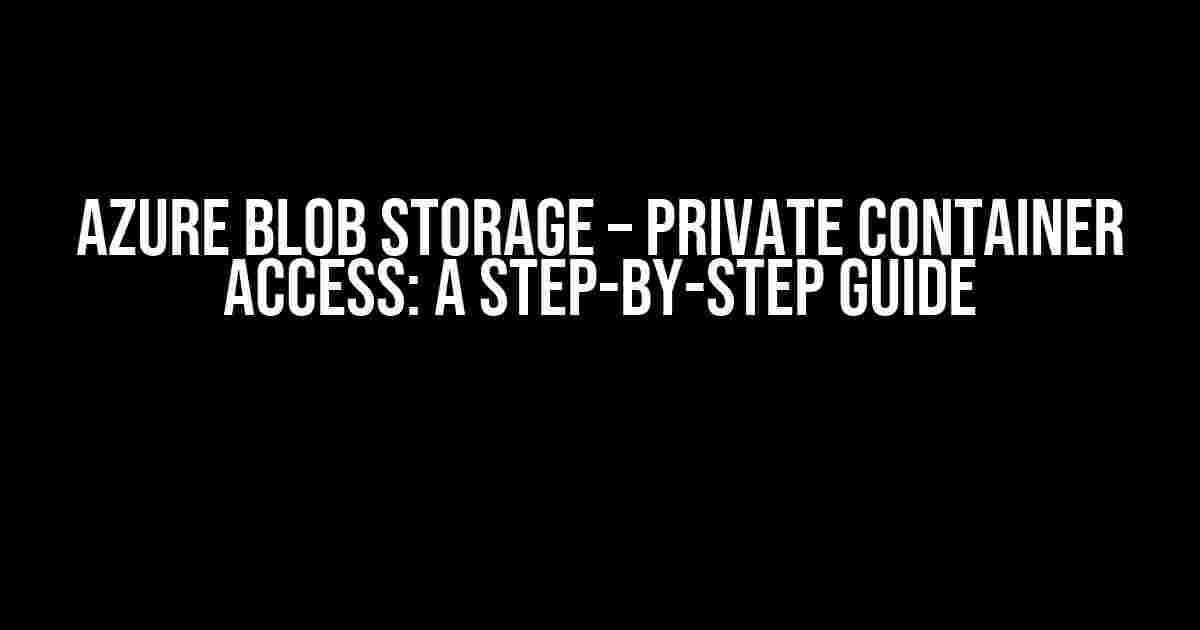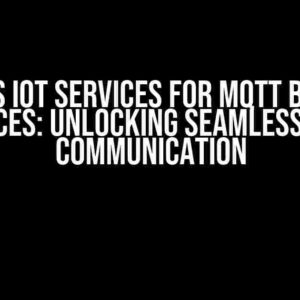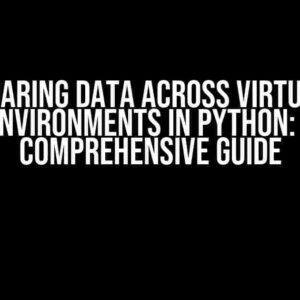Azure Blob Storage is a scalable and secure way to store and manage large amounts of unstructured data. One of the most common use cases for Azure Blob Storage is storing and serving static assets, such as images, videos, and documents. However, when it comes to accessing these assets, security becomes a top concern. In this article, we will dive into the world of Azure Blob Storage and explore how to access a private container securely.
What is Azure Blob Storage?
Azure Blob Storage is a cloud-based object storage service offered by Microsoft Azure. It allows users to store and access large amounts of unstructured data, such as images, videos, documents, and more. Blob Storage provides a highly available, durable, and scalable way to store and manage data, making it an ideal solution for a wide range of applications.
Understanding Private Container Access
In Azure Blob Storage, containers are used to organize and store blobs (files). By default, containers are publicly accessible, meaning anyone with the container URL can access the blobs inside. However, this level of accessibility can be a security risk. That’s where private container access comes in.
Private container access allows you to restrict access to a container, making it accessible only to authorized users or applications. This is achieved through the use of Access Control Lists (ACLs), Shared Access Signatures (SAS), and Azure Active Directory (AAD) authentication.
Benefits of Private Container Access
Implementing private container access provides several benefits, including:
- Improved security: Restricting access to a container reduces the risk of unauthorized access and data breaches.
- Controlled access: Private container access allows you to control who can access the container and its contents.
- Increased compliance: Private container access helps meet regulatory requirements, such as GDPR and HIPAA, by ensuring sensitive data is protected.
Step-by-Step Guide to Private Container Access
Step 1: Create a Private Container
To create a private container, you’ll need to create a new container in Azure Blob Storage and set its access level to “Private”. You can do this using the Azure Portal, Azure CLI, or Azure Storage Explorer.
az storage container create --name--public-access off
Step 2: Generate a Shared Access Signature (SAS)
A Shared Access Signature (SAS) is a URI that grants limited access to a resource for a specified period. To generate a SAS, you’ll need to use the Azure CLI or Azure Storage Explorer.
az storage container generate-sas --name--permissions r --expiry
Step 3: Use the SAS to Access the Private Container
Once you have the SAS, you can use it to access the private container. You can use the SAS to upload, download, or list blobs within the container.
https://.blob.core.windows.net/ ?sv= &ss=b&srt=sco&sp=r&se= &st= &spr=https&sig=
Step 4: Configure Azure Active Directory (AAD) Authentication
Azure Active Directory (AAD) authentication provides a more secure way to access Azure Blob Storage. To configure AAD authentication, you’ll need to:
- Create an Azure AD application and service principal.
- Assign the necessary permissions to the service principal.
- Use the service principal to authenticate with Azure Blob Storage.
Step 5: Use the Azure Storage SDK to Access the Private Container
Once you have configured AAD authentication, you can use the Azure Storage SDK to access the private container. The Azure Storage SDK provides a convenient way to interact with Azure Blob Storage using programming languages like .NET, Java, Python, and more.
// .NET Example
using Microsoft.Azure.Storage.Blob;
using Microsoft.Azure.Storage.Auth;
CloudBlobClient blobClient = new CloudBlobClient(new Uri("https://.blob.core.windows.net"), credential);
CloudBlobContainer container = blobClient.GetContainerReference("");
// Authentication using AAD
TokenCredential tokenCredential = new TokenCredential("https://login.microsoftonline.com//oauth2/v2.0/token");
container.AppendBlob("myblob.txt", "Hello, world!", tokenCredential);
Troubleshooting Private Container Access
When working with private container access, you may encounter issues. Here are some common problems and their solutions:
| Error | Description | Solution |
|---|---|---|
| 403 Forbidden | Unauthorized access to the container. | Check the SAS or AAD authentication configuration. |
| 404 Not Found | Container or blob not found. | Verify the container and blob names, and check the container’s existence. |
| 401 Unauthorized | Invalid credentials or permissions. | Check the Azure AD application and service principal configuration. |
Conclusion
In this article, we’ve explored the world of Azure Blob Storage and private container access. By following the steps outlined in this guide, you can securely access your private container and ensure the integrity of your data. Remember to always prioritize security and follow best practices when working with Azure Blob Storage.
Additional Resources
If you’re new to Azure Blob Storage or want to learn more about private container access, here are some additional resources:
- Azure Blob Storage documentation: https://docs.microsoft.com/en-us/azure/storage/blobs/
- Azure Storage Explorer: https://azure.microsoft.com/en-us/features/storage-explorer/
- Azure CLI: https://docs.microsoft.com/en-us/cli/azure/
- Azure Active Directory documentation: https://docs.microsoft.com/en-us/azure/active-directory/
By mastering private container access, you can take your Azure Blob Storage skills to the next level and unlock the full potential of this powerful cloud-based object storage service.
Frequently Asked Questions
Unlock the secrets of Azure Blob Storage private container access!
What is the purpose of private container access in Azure Blob Storage?
Private container access allows you to securely store and manage sensitive data in Azure Blob Storage, restricting access to only authorized users or services. This ensures that your confidential data remains protected from unauthorized access or breaches.
How do I grant access to a private container in Azure Blob Storage?
You can grant access to a private container by generating a Shared Access Signature (SAS) or using Azure Active Directory (AAD) authentication. A SAS provides temporary, limited access to the container, while AAD authentication allows you to manage access through role-based access control (RBAC).
What are the benefits of using private containers in Azure Blob Storage?
Private containers provide an additional layer of security and control over your data, allowing you to comply with regulatory requirements and industry standards. They also enable you to implement fine-grained access control, track access, and monitor usage.
Can I use Azure Blob Storage private containers for storing sensitive data?
Absolutely! Private containers in Azure Blob Storage are designed to store sensitive data, such as financial records, personal identifiable information (PII), and confidential business documents. They provide the necessary security and access controls to protect your sensitive data.
How do I monitor access to a private container in Azure Blob Storage?
You can monitor access to a private container using Azure Storage Analytics, Azure Monitor, and Azure Storage Explorer. These tools provide detailed logs, metrics, and insights into container access, allowing you to detect and respond to potential security incidents.



